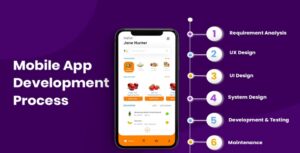Building Defi Apps
DeFi, or Decentralized Finance, is one of the most exciting and rapidly growing areas in the world of blockchain technology. With the growing interest in DeFi apps, many developers are looking to create their own DeFi apps that can be used by users worldwide. However, building a DeFi app can be a complex and challenging process, especially when it comes to mobile app development. In this article, we’ll take a closer look at the mobile app development process for DeFi apps, and explore some of the key insights that developers need to keep in mind.
Understanding the DeFi Ecosystem

Before diving into the mobile app development process for DeFi apps, it’s important to have a solid understanding of the DeFi ecosystem itself. DeFi refers to a wide range of financial applications and platforms that are built on dapp blockchain application development networks, rather than traditional financial systems. This enables DeFi apps to offer a range of benefits, such as lower transaction fees, faster processing times, and greater transparency and security.
To build a DeFi app, developers need to have a strong understanding of the underlying blockchain technology, as well as the various protocols, tools, and standards that are used in the DeFi ecosystem. Some of the most popular DeFi protocols and tools include Ethereum, Solidity, Web3.js, and Truffle. Developers also need to have a good grasp of smart contracts. Which are self-executing contracts that automatically enforce the rules and regulations of a particular application or platform.
The Advantages of DeFi Apps
There are several advantages of DeFi apps that make them an attractive proposition for users:
- Accessibility: DeFi apps can be accessed from anywhere in the world, as long as there is an internet connection.
- Security: The decentralized nature of DeFi apps makes them more secure as they are not controlled by any central authority.
- Transparency: All transactions in DeFi apps are recorded on a public blockchain, providing transparency to all users.
- Lower transaction fees: DeFi apps offer lower transaction fees than traditional financial institutions.
Designing the User Interface
One of the most important aspects of building a successful DeFi app is designing a user-friendly and intuitive interface that makes it easy for users to interact with the platform. This involves creating wireframes and mockups of the app’s screens and features. As well as identifying key user flows and testing the design with actual users.
When designing the user interface for a DeFi app, developers need to consider a range of factors. Such as the target audience, the app’s core features, and the overall branding and aesthetic. The app’s design should be consistent and cohesive, with clear and concise labels, buttons, and instructions. Additionally, it’s important to ensure that the app’s design is optimized for mobile devices. As many users will be accessing the app on their smartphones or tablets.
Developing the App
Once the user interface has been designed and tested, the development phase can begin. This involves writing the code that powers the app’s various features and functions. As well as integrating the app with the underlying blockchain network.
DeFi, or Decentralized Finance, is one of the most exciting and rapidly growing areas in the world of blockchain technology. With the growing interest in DeFi apps, many developers are looking to create their own DeFi apps that can be used by users worldwide. However, building a DeFi app can be a complex and challenging process, especially when it comes to mobile app development. In this article, we’ll take a closer look at the mobile app development company New York-based to know the mobile app development process, and explore some of the key insights that developers need to keep in mind.
Testing and Launching the App
Once the app has been developed, it’s important to thoroughly test it to ensure that it’s functioning as intended and is free from bugs and errors. This involves a range of testing techniques, such as unit testing, integration testing, and end-to-end testing, as well as user testing to get feedback from actual users.
Once the app has been tested and refined, it can be launched to the public. This involves deploying the app to various app stores and marketplaces. As well as promoting the app through social media, advertising, and other channels. Developers should also continue to monitor the app’s performance and user feedback, and make updates and improvements as necessary.
Conclusion
Building DeFi apps is an exciting and challenging task that requires careful planning, design, and development. Mobile app development is an essential aspect of building DeFi apps. It is crucial to choose the right platform, keep the app simple, and ensure security.
With the right approach, building DeFi apps can be a rewarding experience.

3 thoughts on “Building Defi Apps: An insight of the mobile app development process”